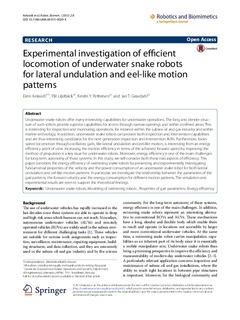| dc.contributor.author | Kelasidi, Eleni | |
| dc.contributor.author | Liljebäck, Pål | |
| dc.contributor.author | Pettersen, Kristin Ytterstad | |
| dc.contributor.author | Gravdahl, Jan Tommy | |
| dc.date.accessioned | 2015-12-18T09:25:35Z | |
| dc.date.accessioned | 2016-01-20T14:47:40Z | |
| dc.date.available | 2015-12-18T09:25:35Z | |
| dc.date.available | 2016-01-20T14:47:40Z | |
| dc.date.issued | 2015 | |
| dc.identifier.citation | Robotics and Biomimetics 2015, 2(8) | nb_NO |
| dc.identifier.issn | 2197-3768 | |
| dc.identifier.uri | http://hdl.handle.net/11250/2374406 | |
| dc.description.abstract | Underwater snake robots offer many interesting capabilities for underwater operations. The long and slender structure of such robots provide superior capabilities for access through narrow openings and within confined areas. This is interesting for inspection and monitoring operations, for instance within the subsea oil and gas industry and within marine archeology. In addition, underwater snake robots can provide both inspection and intervention capabilities and are thus interesting candidates for the next generation inspection and intervention AUVs. Furthermore, bioinspired locomotion through oscillatory gaits, like lateral undulation and eel-like motion, is interesting from an energy efficiency point of view. Increasing the motion efficiency in terms of the achieved forward speed by improving the method of propulsion is a key issue for underwater robots. Moreover, energy efficiency is one of the main challenges for long-term autonomy of these systems. In this study, we will consider both these two aspects of efficiency. This paper considers the energy efficiency of swimming snake robots by presenting and experimentally investigating fundamental properties of the velocity and the power consumption of an underwater snake robot for both lateral undulation and eel-like motion patterns. In particular, we investigate the relationship between the parameters of the gait patterns, the forward velocity and the energy consumption for different motion patterns. The simulation and experimental results are seen to support the theoretical findings. | nb_NO |
| dc.language.iso | eng | nb_NO |
| dc.publisher | SpringerOpen | nb_NO |
| dc.title | Experimental investigation of efficient locomotion of underwater snake robots for lateral undulation and eel-like motion patterns | nb_NO |
| dc.type | Journal article | nb_NO |
| dc.date.updated | 2015-12-18T09:25:35Z | |
| dc.source.volume | 2 | nb_NO |
| dc.source.journal | Robotics and Biomimetics | nb_NO |
| dc.source.issue | 8 | nb_NO |
| dc.identifier.doi | 10.1186/s40638-015-0029-4 | |
| dc.identifier.cristin | 1302340 | |
| dc.description.localcode | © 2015 Kelasidi et al. This article is distributed under the terms of the Creative Commons Attribution 4.0 International License (http://creativecommons.org/licenses/by/4.0/), which permits unrestricted use, distribution, and reproduction in any medium, provided you give appropriate credit to the original author(s) and the source, provide a link to the Creative Commons license, and indicate if changes were made. | nb_NO |
